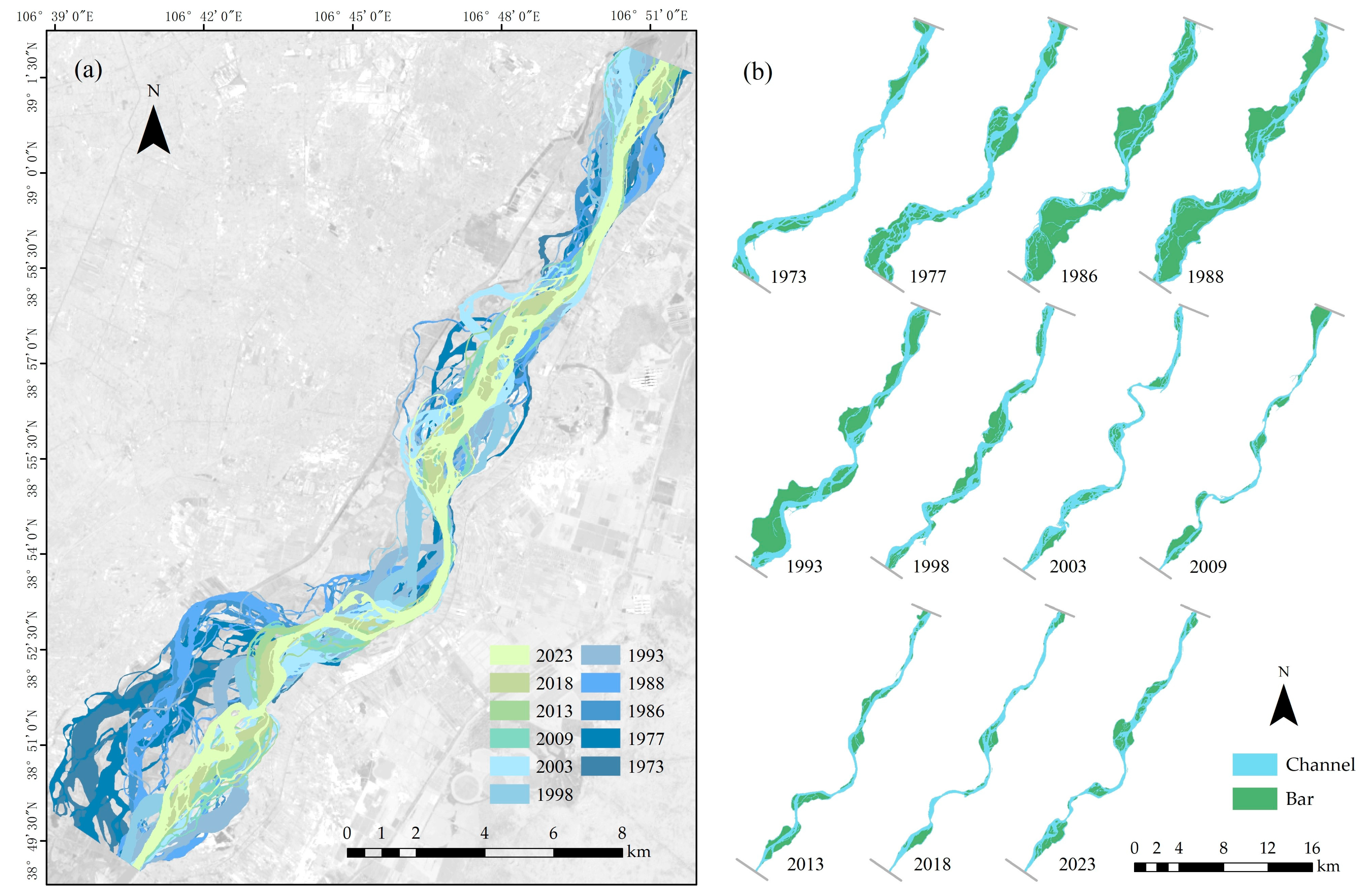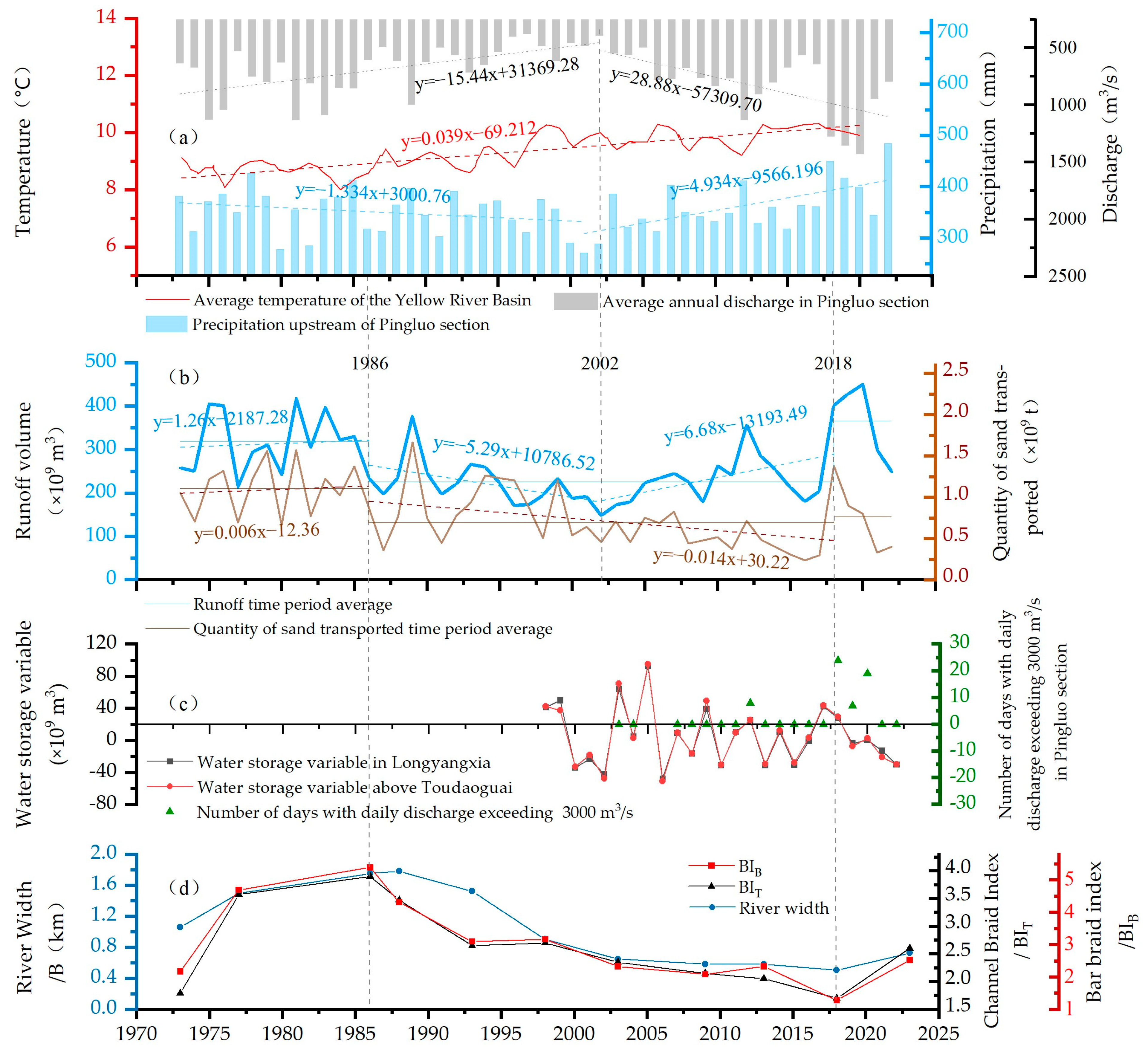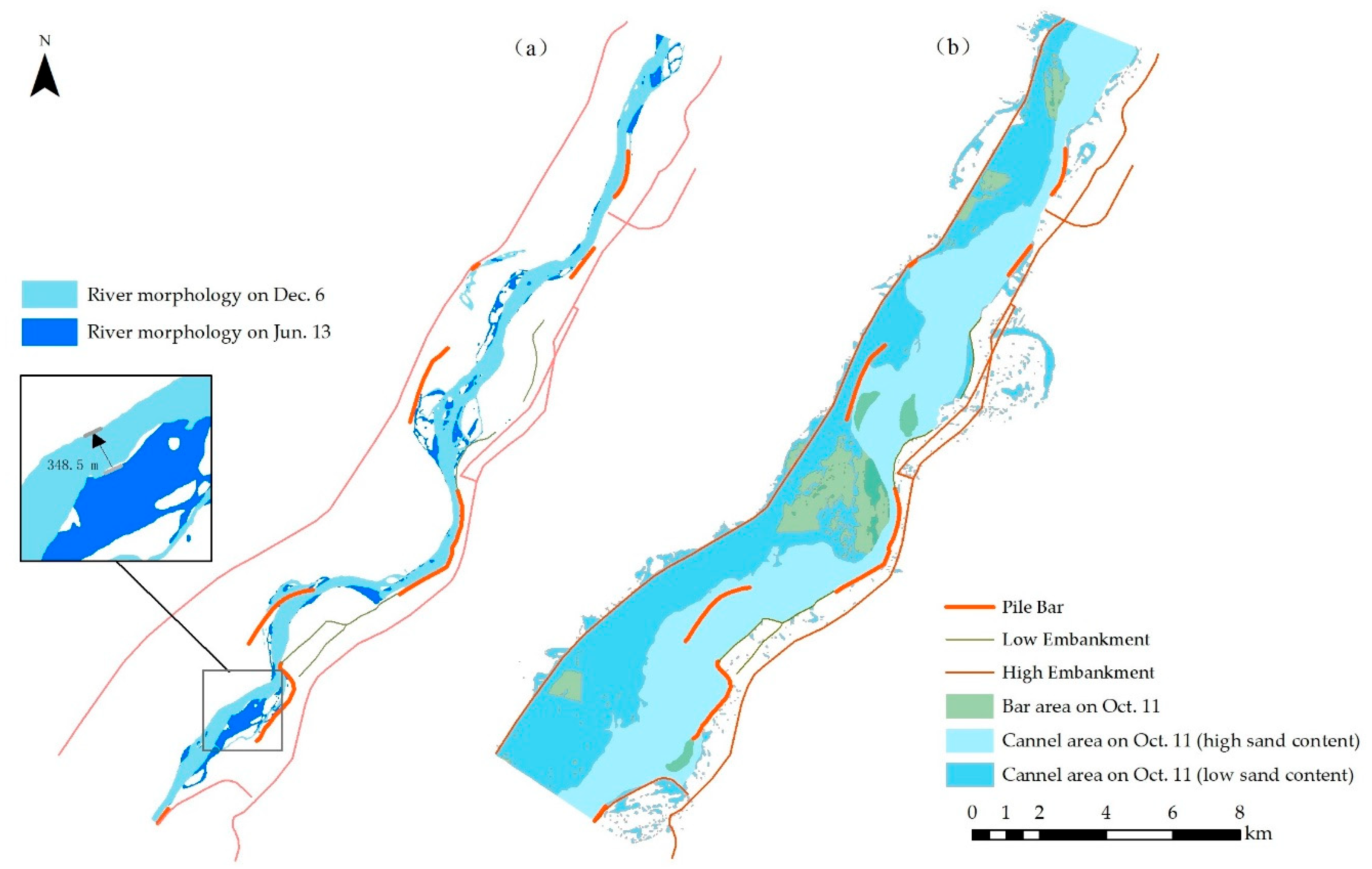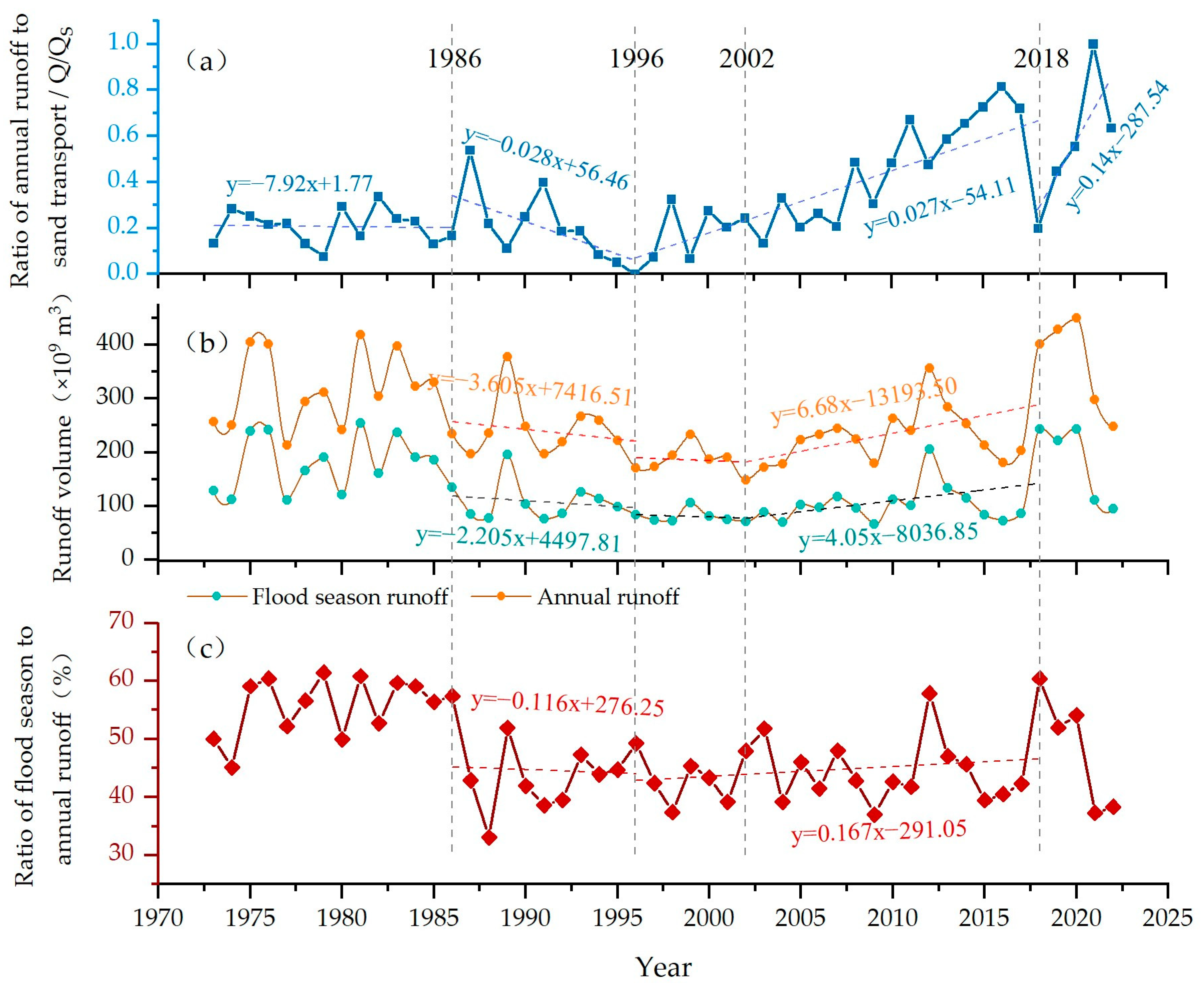Evolution of the Pingluo Section of the Upper Yellow River over the Past 50 Years: Responses to Environmental Change and Human Activity
Abstract
:1. Introduction
2. Study Area
3. Methods
3.1. Data Acquisition and Processing
3.2. Riverine Shoreline Extraction
3.3. River Morphology Indicators
4. Results and Discussion
4.1. Characteristics of Channel Evolution
4.2. Characteristics of Tributary Bars
4.3. Analysis of Factors Influencing River Channel Evolution along the Pingluo Section over the Past 50 Years
4.3.1. Response of River Channel Evolution to Climate Change
4.3.2. Impact of Human Activity on River Channel Evolution
- (1)
- Impact of water conservancy facilities
- (2)
- Influence of dike protection facilities
5. Conclusions
Author Contributions
Funding
Data Availability Statement
Acknowledgments
Conflicts of Interest
References
- Zhang, J.; Wang, G.; He, R.; Liu, C. Variation trends of runoffs in the Middle Yellow River Basin and its response to climate change. Adv. Water Sci. 2009, 20, 153–158. [Google Scholar]
- IPCC. Contribution of Working Groups I, II and III to the Sixth Assessment Report of the Intergovernmental Panel on Climate Change. In Climate Change 2023: Synthesis Report; IPCC: Geneva, Switzerland, 2023. [Google Scholar]
- Dewan, A.M.; Robert, J.C.; Saleem, A.; Rahman, M.M.; Haider, M.R.; Rahman, M.M.; Sarker, M.H. Assessing channel changes of the Ganges-Padma River system in Bangladesh using Landsat and hydrological data. Geomorphology 2017, 267, 257–279. [Google Scholar] [CrossRef]
- Baniya, S.; Deshar, R.; Chauhan, R.; Thakuri, S. Assessment of channel migration of Koshi River in Nepal using remote sensing and GIS. Environ. Chall. 2023, 11, 100692. [Google Scholar] [CrossRef]
- LuoZada, R.O.; Roque, F.O.; Diniz, J.M.S.; Bergier, I. River channel avulsion in the Taquari River megafan of the Brazilian Pantanal: Remote sensing and modeling reveal recent and future changes. Appl. Geogr. 2023, 155, 102955. [Google Scholar] [CrossRef]
- Wu, Q.; Ke, L.; Wang, J.; Pavelsky, T.M.; Allen, G.H.; Sheng, Y.; Duan, X.; Zhu, Y.; Wu, J.; Wang, L.; et al. Satellites reveal hotspots of global river extent change. Nat. Commun. 2023, 14, 1587. [Google Scholar] [CrossRef]
- Zheng, G.; Allen, S.K.; Bao, A.; Cánovas, J.A.B.; Huss, M.; Zhang, G.; Li, J.; Yuan, Y.; Jiang, L.; Yu, T.; et al. Increasing risk of glacial lake outburst floods from future Third Pole deglaciation. Nat. Clim. Change 2021, 11, 411–417. [Google Scholar] [CrossRef]
- Wellmeyer, L.L.; Slattery, M.C.; Phillips, J.D. Quantifying downstream impacts of impoundment on flow regime and channel planform, lower Trinity River, Texas. Geomorphology 2005, 69, 1–13. [Google Scholar] [CrossRef]
- Ran, L.; Wang, S.; Fan, X. Channel change at Toudaoguai Station and its responses to the operation of upstream reservoirs in the Upper Yellow River. J. Geogr. Sci. 2010, 20, 231–247. [Google Scholar] [CrossRef]
- Magliulo, P.; Bozzi, F.; Leone, G.; Fiorillo, F.; Leone, N.; Russo, F.; Valente, A. Channel adjustments over 140 years in response to extreme floods and land-use change, Tammaro River, southern Italy. Geomorphology 2021, 383, 107715. [Google Scholar] [CrossRef]
- Adib, A.; Foladfar, H.; Roozy, A. Role of construction of large dams on river morphology (case study: The Karkheh dam in Iran). Arab. J. Geosci. 2016, 9, 661. [Google Scholar] [CrossRef]
- Schumm, S.A. River Variability and Complexity; Cambridge University Press: New York, NY, USA, 2005; pp. 70–73. [Google Scholar]
- Dethier, E.N.; Renshaw, C.E.; Magilligan, F.J. Rapid changes to global river suspended sediment flux by humans. Science 2022, 376, 1447–1452. [Google Scholar] [CrossRef] [PubMed]
- Gilvear, D.; Winterbottom, S.; Sichingabula, H. Character of channel planform change and meander development: Luangwa River, Zambia. Earth Surf. Proc. Land. 2000, 25, 421–436. [Google Scholar] [CrossRef]
- Yang, X.; Damen, M.C.J.; Van Zuidam, R.A. Satellite remote sensing and GIS for the analysis of channel migration changes in the active Yellow River Delta, China. Int. J. Appl. Earth Obs. 1999, 1, 149–157. [Google Scholar] [CrossRef]
- Lane, E.W. The Importance of Fluvial Morphology in Hydraulic Engineering. Proc. Am. Soc. Civ. Eng. 1955, 81, 1–17. [Google Scholar] [CrossRef]
- Nones, M. Remote sensing and GIS techniques to monitor morphological changes along the middle-lower Vistula river, Poland. Int. J. River Basin. Manag. 2021, 19, 345–357. [Google Scholar] [CrossRef]
- Zhang, J.; Shang, Y.; Liu, J.; Fu, J.; Wei, S.; Tong, L. Causes of Variations in Sediment Yield in the Jinghe River Basin, China. Sci. Rep. 2020, 10, 18054. [Google Scholar] [CrossRef]
- Yang, S.; Ding, J.; Chen, X.; Zhao, G.; Chen, Y. Analysis on ice flood in Ningxia Section of Yellow River in last 13 years. J. Desert Res. 2005, 25, 141–145. [Google Scholar]
- Fan, X.; Shi, C.; Zhou, Y.; Shao, W. Sediment rating curves in the Ningxia-Inner Mongolia reaches of the Upper Yellow River and their implications. Quatern. Int. 2012, 282, 152–162. [Google Scholar] [CrossRef]
- Liu, C.; Zhang, X. Causal analysis on actual water flow reduction in the mainstream of the Yellow River. Acta Geogr. Sin. 2004, 59, 323–330. [Google Scholar]
- Xu, J. A Study on the coupling relation between the water and sediment yield sub-system and river channel deposition sub-system: An example from the Yellow River. Acta Geogr. Sin. 1997, 52, 39–47. [Google Scholar]
- Zhao, W.; Cheng, X.; Hou, S.; Li, H. Analysis of scouring and sedimentation in the channel from Ningxia to Inner Mongolia in the Upper Yellow River. Yellow River 1999, 21, 13–16. [Google Scholar]
- Xu, J. Response of bankfull discharge to human activity and climate change: The Inner Mongolia Reach of the Upper Yellow River. Sci. Geogr. Sin. 2016, 36, 837–845. [Google Scholar]
- Zhang, X.; Pan, Q. Investigation and Assessment of the Yellow River Water Resources; Yellow River Water Resources Publishing House: Zhengzhou, China, 2006. (In Chinese) [Google Scholar]
- McFeeters, S.K. The use of the Normalized Difference Water Index (NDWI) in the delineation of open water features. Int. J. Remote Sens. 1996, 17, 1425–1432. [Google Scholar] [CrossRef]
- Hong, L.B.; Davies, T.R.H. A study of stream braiding. Geol. Soc. Am. Bull. 1979, 90, 1839–1859. [Google Scholar] [CrossRef]
- Germanoski, D.; Schumm, S.A. Changes in braided river morphology resulting from aggradation and degradation. J. Geol. 1993, 101, 447–462. [Google Scholar] [CrossRef]
- Huo, F.; Pan, X.; You, G.; Zheng, Z.; Liao, H.; Zhou, T.; Zhang, G.; Xu, G.; Liu, Z.; Gui, Z. Introduction to Geology of Ningxia, 1st ed.; Science Press: Beijing, China, 1989; p. 5. [Google Scholar]
- Deng, Q.; Sung, F.; Zhu, S.; Li, M.; Wang, T.; Zhang, W.; Burchfiel, B.C.; Molar, P.; Zhang, P. Active faulting and tectonics of the Ningxia-Hui Autonomous Region, China. J. Geophys. Res. 1984, 89, 4427–4445. [Google Scholar]
- Hickin, E.J. River Channel Changes: Retrospect and Prospect. Mod. Anc. Fluv. Syst. 1983, 6, 61–83. [Google Scholar]
- Wang, S.; Yan, Y.; Yan, M.; Zhao, X. Contributions of precipitation and human activities to the runoff change of the Huangfuchuan Drainage Basin: Application of comparative method of the slope changing ratio of cumulative quantity. Acta Geogr. Sin. 2012, 67, 388–397. [Google Scholar]
- Condon, L.E.; Atchley, A.L.; Maxwell, R.M. Evapotranspiration depletes groundwater under warming over the contiguous United States. Nat. Commun. 2020, 11, 873. [Google Scholar] [CrossRef]
- Humphrey, V.; Zscheischler, J.; Ciais, P.; Gudmundsson, L.; Sitch, S.; Seneviratne, S.I. Sensitivity of atmospheric CO2 growth rate to observed changes in terrestrial water storage. Nature 2018, 560, 628–631. [Google Scholar] [CrossRef]
- Zhang, S.; Yu, W.; Zhang, H. Sediment characteristic and the variety trend analysis for upstream Yellow River. J. Water Resour. Water Eng. 2005, 16, 57–61. [Google Scholar]
- Shang, H.; Zheng, Y.; Zhang, X. Influence of reservoir operation to the silt-discharge condition of Ning-Meng Section of the Yellow River. Yellow River 2008, 30, 28–30. [Google Scholar]
- Xu, J. The influence of dilution on downstream channel sedimentation in large rivers: The Yellow River, China. Earth Surf. Proc. Land. 2014, 39, 450–462. [Google Scholar] [CrossRef]
- Yellow River Conservancy Commission of the Ministry of Water Resources. Available online: http://www.yrcc.gov.cn/nishagonggao/2018/index.html#p=1 (accessed on 11 October 2023).
- Ningxia Hui Autonomous Region People’s Government. Available online: https://www.nx.gov.cn/zwxx_11337/zwdt/202104/t20210409_2704564.html (accessed on 11 March 2023).
- Liu, X.; Hou, S.; Chang, W. Cause of main channel shrinkage occurred to the Inner-Mongolia reaches of Yellow River. J. Hydraul. Engasc. 2009, 40, 1048–1054. [Google Scholar]
- Wang, H.; Sun, F. Variability of annual sediment load and runoff in the Yellow River for the last 100 years (1919–2018). Sci. Total Environ. 2021, 758, 143715. [Google Scholar] [CrossRef]
- Wu, X.; Wang, S.; Fu, B.; Feng, X.; Chen, Y. Socio-ecological changes on the Loess Plateau of China after Grain to Green Program. Sci. Total Environ. 2019, 678, 565–573. [Google Scholar] [CrossRef]
- Han, S.; Ma, Z.; Zhuang, W.; Lu, H.; Liu, T.; Shen, J. Spatial-temporal change of Leaf Area Index (LAI) in the source region of the Yellow River during 2000–2018. J. Irrig. Drain. 2019, 38, 57–62. [Google Scholar]
- Fan, X.; Shi, C.; Bai, J.; Yao, H. Study on sediment delivery rate in the Ningxia-Inner Mongolia reaches of the upper Yellow River. Int. J. Sediment. Res. 2015, 6, 27–33. [Google Scholar]
- Hou, S.; Wang, P.; Chang, W.; Chu, W. Evaluation on the Volume of Scour and Fill of Inner Mongolia Section of the Yellow River. Yellow River 2007, 29, 21–22. [Google Scholar]
- Zhao, Y.; Liu, X.; Luo, J.; Ke, Y.; Zhang, X. Fluctuation Characteristics of Runoff and Sediment in the Trunk River in Ningxia Section of Yellow River from 2009 to 2019. Ningxia J. Agri. Fores 2023, 64, 42–47. [Google Scholar]
- Wang, S.; Li, L. Lateral shift rate variation of the river banks in the Yinchuan Plain reach of the Yellow River and its causes. Acta Geogr. Sin. 2014, 699, 399–408. [Google Scholar]








| Data Series | Sensor Type | Imaging Time | Resolution (m) |
|---|---|---|---|
| Landsat 1 | MSS | December 1973 | 60 |
| Landsat 2 | MSS | October 1977 | 60 |
| Landsat 5 | TM | November 1986 | 30 |
| Landsat 5 | TM | December 1988 | 30 |
| Landsat 5 | TM | November 1993 | 30 |
| Landsat 5 | TM | December 1998 | 30 |
| Landsat 5 | TM | March 2003 | 30 |
| Landsat 5 | TM | February 2009 | 30 |
| Landsat 8 | OIL | November 2013 | 30 |
| Landsat 8 | OIL | November 2018 | 30 |
| Landsat 8 | OIL | March 2023 | 30 |
| River Morphology Parameters | Formula | Description of the Formula |
|---|---|---|
| River area (A) | A is the total area of the reach of the river, including the area of the wet channel (AW) and the area of all the islands and/or sandbars (AB). | |
| River width (B) | 1 | Bi is the width of the furthest two sides of the branch on the i-th cross section along the river flow [4]. |
| Channel braiding index (BIT) | Nwi is the number of branching channels in the i-th cross section along the river flow [27]. | |
| Wet channel area (AW) | - | AW is the total water area of the reach. |
| Wet channel width (BW) | Bwi is the total width of the river flow path on section i. Bwi-j is the width of the j-th branch in the i-th cross-section along the flow of the river. | |
| Bar braiding index (BIB) | Lb is the length of each island and/or sandbar in the reach, NB is the total number of islands and/or sandbars in the reach, and Lr is the straight-line distance between the upper and lower ends of the reach [28]. | |
| Area of the bar (AB) | - | AB is the total area of all islands and/or sandbars in the reach. |
| Average area of the bar (Ab) | Ab is the average area of all islands and/or sandbars in the reach. |
Disclaimer/Publisher’s Note: The statements, opinions and data contained in all publications are solely those of the individual author(s) and contributor(s) and not of MDPI and/or the editor(s). MDPI and/or the editor(s) disclaim responsibility for any injury to people or property resulting from any ideas, methods, instructions or products referred to in the content. |
© 2024 by the authors. Licensee MDPI, Basel, Switzerland. This article is an open access article distributed under the terms and conditions of the Creative Commons Attribution (CC BY) license (https://creativecommons.org/licenses/by/4.0/).
Share and Cite
Liang, S.; Yan, T.; Gao, H.; Jing, C.; He, F.; Han, M. Evolution of the Pingluo Section of the Upper Yellow River over the Past 50 Years: Responses to Environmental Change and Human Activity. Water 2024, 16, 911. https://doi.org/10.3390/w16060911
Liang S, Yan T, Gao H, Jing C, He F, Han M. Evolution of the Pingluo Section of the Upper Yellow River over the Past 50 Years: Responses to Environmental Change and Human Activity. Water. 2024; 16(6):911. https://doi.org/10.3390/w16060911
Chicago/Turabian StyleLiang, Shuyu, Tianqi Yan, Hongshan Gao, Chuantao Jing, Fei He, and Meiqin Han. 2024. "Evolution of the Pingluo Section of the Upper Yellow River over the Past 50 Years: Responses to Environmental Change and Human Activity" Water 16, no. 6: 911. https://doi.org/10.3390/w16060911





